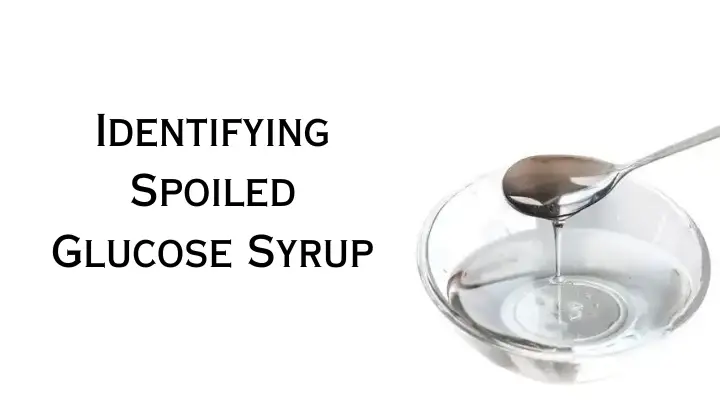One might wonder, does glucose syrup go bad? Glucose syrup, a commonly used sweetening agent derived primarily from corn, prompts this important question.
This ubiquitous ingredient, found in everything from candies and jellies to baked goods and soft drinks, is known for its sweet taste and texture-enhancing properties.
While its culinary applications are many, understanding its shelf life is equally important to ensure the quality and safety of the foods it’s incorporated into.
If you are interested in syrups and coffees, you may also want to read the do Torani syrups go bad, does pumpkin syrup expire and how long does Turkish coffee last in articles that we shared before.
Glucose Syrup Expire Date
Yes, glucose syrup has an expiration date. The average expiration date of glucose syrup is 2 years.
Glucose syrup is a commonly used sweetener and thickening agent in various food products, ranging from candies and desserts to sauces and beverages.
It’s versatility and long shelf life make it a staple in many kitchens and food manufacturing facilities. However, like most food items, glucose syrup can go bad over time, especially when not stored correctly.
If you have purchased glucose syrup ready, be sure to check the expiry date on its packaging before consuming it.
If you like syrup, our article Does Torani Syrup Go Bad, Does Elderberry Syrup Go Bad, and Does Pumpkin Syrup Expire may interest you.

Glucose Syrup Shelf Life
The longevity of glucose syrup primarily depends on its storage conditions. When stored correctly, an unopened bottle of glucose syrup can last for up to two years in a cool, dry place.
Once opened, it retains its quality for about six months if stored in an airtight container in a cool, dry area. Always inspect the syrup for any changes in color, consistency, or smell before use.

Does Glucose Syrup Go Bad if Not Refrigerated?
While glucose syrup doesn’t require refrigeration, it should still be stored in a cool, dry place away from direct sunlight. Exposure to heat and sunlight can cause glucose syrup to degrade faster, affecting its taste, texture, and overall quality.
How long does glucose syrup last in the refrigerator?
Glucose syrup, also known as corn syrup, is a type of sweetener and food preservative that is commonly used in cooking and baking. It has a high sugar content and a low water content, which helps it resist the growth of bacteria and molds.
Typically, an unopened bottle of glucose syrup can last indefinitely in the pantry if it is stored correctly, i.e., in a cool, dark place away from heat sources. Once opened, however, the shelf life can be affected by how the syrup is stored.
If you store an opened bottle of glucose syrup in the refrigerator, it can last for about two years, but possibly longer. It’s important to ensure that the cap is tightly sealed when not in use to prevent moisture from getting in, which could lead to the growth of mold.
However, it’s always best to check for signs of spoilage such as changes in color, texture, or smell. If you have encountered any of these symptoms, it is best to throw away the syrup and buy a new one.
How Long Does Glucose Syrup Last After Opening?
Once opened, glucose syrup should be used within six months for optimal quality. Ensure that the cap is tightly sealed after each use to prevent the syrup’s exposure to air and bacteria that can accelerate spoilage.
What Happens If You Consume Expired Glucose Syrup?
The consumption of expired glucose syrup may not result in immediate health issues as it does not typically harbor dangerous bacteria. However, it is essential to understand the potential effects and considerations associated with using glucose syrup past its expiration date.
- Reduced Quality and Taste: As glucose syrup ages, its quality may deteriorate, resulting in changes to its taste and texture. The syrup may become less sweet or develop off-flavors, making it less enjoyable in culinary applications. The texture might also undergo changes, becoming grainy or thicker, which can impact the consistency of recipes.
- Decreased Nutritional Value: While the nutritional content of glucose syrup remains relatively stable over time, the expired syrup might experience slight degradation in its properties. The syrup’s ability to provide an immediate source of energy may diminish slightly, but this decline is generally not significant.
- Potential for Digestive Discomfort: In some cases, consuming expired glucose syrup that has been contaminated with mold or other microbes might lead to mild digestive discomfort. This could include symptoms such as stomach upset, bloating, or diarrhea. However, it’s worth noting that the likelihood of such issues arising from expired glucose syrup is relatively low.
- Ineffective Sweetening in Recipes: Expired glucose syrup may not perform as effectively in recipes that rely on its sweetening properties. The decreased sweetness level could result in less desirable culinary outcomes. To avoid disappointments in your cooking and baking endeavors, it’s best to use fresh and unexpired glucose syrup when possible.
- Risk of Rancidity: If glucose syrup contains fats or oils (as sometimes found in flavored syrups), these components can become rancid over time. Rancidity not only imparts an unpleasant taste but also leads to the breakdown of essential nutrients, rendering the syrup less nutritious.
- Allergic Reactions: Although rare, some individuals may be sensitive or allergic to certain components present in glucose syrup. As the syrup ages, there is a slight chance that its chemical composition may change, potentially triggering allergic reactions in susceptible individuals.
In summary, consuming expired glucose syrup is generally not a severe health risk, but it may result in diminished taste and quality in your culinary creations.
If the syrup exhibits any signs of spoilage, such as an odd smell, changed color, or visible mold, it’s crucial to dispose of it properly. To ensure the best outcomes in your cooking and maintain the syrup’s quality, it’s advisable to use fresh glucose syrup within its recommended shelf life and store it appropriately in a cool, dry place away from contaminants.
Always check the expiration date on the packaging before use and trust your senses – if something seems off, it’s best to err on the side of caution and avoid using the syrup.
SEE OFFER 👉🏻 glucose syrup
Identifying Spoiled Glucose Syrup
To ensure the safety and quality of glucose syrup in your recipes and food preparations, it’s crucial to be able to identify signs of spoilage. While glucose syrup generally has a long shelf life, improper storage or prolonged exposure to unfavorable conditions can lead to its deterioration. Here are some key indicators to watch out for when identifying spoiled glucose syrup:
- Changes in Color: One of the first visible signs of glucose syrup spoilage is a change in color. The syrup may darken or become cloudy, indicating that it has undergone chemical changes or has been contaminated with impurities. Ideally, glucose syrup should have a clear and transparent appearance, so any noticeable discoloration could be a cause for concern.
- Altered Consistency: A healthy glucose syrup typically possesses a smooth and runny consistency. If you notice that the syrup has become thicker or has developed a gel-like texture, it is likely past its prime. Changes in consistency may also be a result of water absorption, which can happen if the syrup is not adequately sealed or stored in a humid environment.
- Unusual Odor: Another telltale sign of spoiled glucose syrup is an unusual or off-putting odor. The syrup should have a neutral, sweet aroma, but if it emits a sour, rancid, or moldy smell, it’s best to avoid using it. A change in smell could indicate fermentation, microbial growth, or the presence of contaminants.
- Presence of Mold or Particles: Inspect the syrup for any visible signs of mold growth or foreign particles floating within it. If you notice any specks, spots, or clumps, it is a definitive indication that the glucose syrup has spoiled and should be discarded immediately. Consuming syrup with visible mold or particles poses health risks and can lead to digestive issues.
- Expired “Best By” Date: Always check the expiration date on the glucose syrup packaging. While the absence of spoilage signs does not guarantee that the syrup is still in optimal condition, an expired “best by” date should raise caution. The quality and taste of the syrup might have degraded even if no visible signs of spoilage are present.
- Changes in Taste: In addition to visual and olfactory cues, taste changes can also indicate glucose syrup spoilage. If the syrup tastes unusually sour, bitter, or different from its usual sweetness, it is best not to use it in your recipes.
In conclusion, being able to identify spoiled glucose syrup is crucial to maintaining the quality and safety of your culinary creations. If you encounter any of the aforementioned signs, it’s advisable to err on the side of caution and dispose of the syrup properly.

Correct Storage of Glucose Syrup
Proper storage is vital for preserving the quality and extending the shelf life of glucose syrup. The following tips will ensure that your glucose syrup remains fresh and ready to use:
- Seal Tightly: Always tightly close the cap after use to prevent air exposure.
- Cool and Dry Location: Store the syrup in a cool, dark place, away from direct sunlight.
- Avoid Contamination: Use clean utensils to prevent the introduction of bacteria or other contaminants.
Questions about does glucose syrup go bad
In this section, we’ll answer some common questions about Glucose Syrup and storage:
What is glucose syrup?
Glucose syrup is a sweetening agent derived from the hydrolysis of glucose (commonly corn) starch. It’s widely used in the food industry due to its sweetening properties and its ability to enhance texture and shelf life.
Does glucose syrup go bad?
Yes, glucose syrup can go bad, especially if not stored correctly. Unopened, it can last up to two years, and once opened, it should be used within six months.
What happens if you consume expired glucose syrup?
Consuming expired glucose syrup might result in a reduction of its quality due to the degradation of its sweetening properties. If it has developed mold or bacteria, it could lead to foodborne illnesses.
How should I store glucose syrup?
Glucose syrup should be stored in a cool, dry place. Once opened, ensure the bottle is tightly sealed to prevent exposure to air and potential contaminants.
Can I freeze glucose syrup?
Glucose syrup does not need to be frozen and can be stored in a cool, dry place, such as a pantry. Freezing is not recommended as it may alter the syrup’s consistency.
How can I tell if my glucose syrup has gone bad?
Signs of glucose syrup spoilage include changes in color, consistency, or smell. The presence of mold or floating particles also indicates spoilage.
As a rule of thumb, always prioritize safety and quality. If you suspect that your glucose syrup has gone bad, it’s best to discard it.
You can also take a look at the following articles for foods that you should pay attention to before consuming: Does cornstarch expire, how long do bagels last, do energy drinks expire, does Turkish Coffee go bad, does Nespresso capsules go bad, why does pasta go bad, Do Capers Go Bad, and does kombucha expire?

